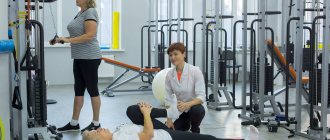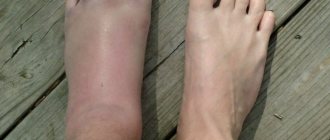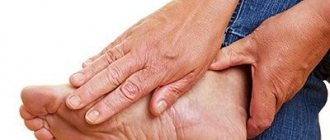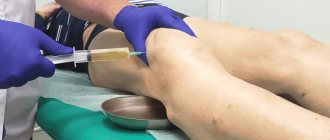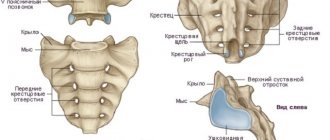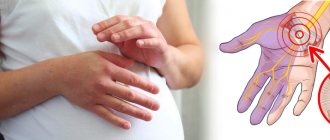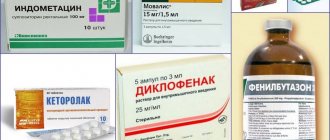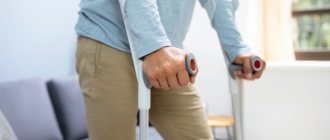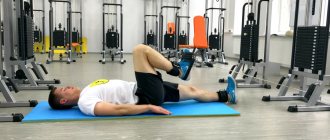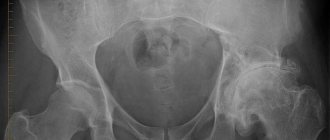Joint pain, regardless of its location, can significantly disrupt the usual rhythm of life. Joint pain is never spontaneous; it always indicates the presence of an injury or disease. And joint pain will never go away on its own, but will only progress.
Unfortunately, conventional painkillers, regardless of the form (tablets or injections), do not take effect immediately; often improvement does not occur until the third day.
But there is another method - this is the injection of a drug into the affected joint. Injecting drugs directly into the joint helps to achieve the fastest possible effect, because the drug does not need to overcome barriers and undergo changes under the influence of metabolism - the drug immediately begins to work and relief (reduced pain, increased mobility) is achieved as quickly as possible.
Intra-articular injections are an invasive method of treating joints aimed at restoring joint function based on the introduction of medications directly into the joint cavity. The technique helps relieve inflammation, achieve adequate pain relief in the shortest possible time, stop progressive degenerative processes and even promote the regeneration of damaged tissues.
Advantages of intra-articular injections:
- Quick results. Unlike taking drugs in tablet form, intramuscular or even intravenous injections, when the drug is administered directly into the joint, the result comes many times faster. Indeed, in this case, time is not required for the distribution and accumulation of the medicine in the desired area - it has already been delivered by a specialist directly to the problem area and immediately begins to work. Moreover, tablet forms of drugs aimed at restoring cartilage tissue usually require several months to begin working, and when administered intra-articularly, stimulation of regeneration is provided within several hours after injection and lasts as long as the active substance is in the synovial cavity, that is, until moment of natural resorption of the drug.
- Reduced side effects. Again, when taking drugs orally, there is a load on other organs and systems, for example, NSAIDs for pain relief negatively affect the functions of the gastrointestinal tract. Also, with intra-articular administration of drugs, the drug load on the liver and kidneys is reduced, which cannot be avoided with systemic use of drugs.
- Long lasting effect. Unlike other types of therapy, which require frequent repetition of courses, the therapeutic effect of intra-articular injections can last up to a year (and in some cases even longer). The duration of action depends on the drug used, the diagnosis and the degree of damage to the joint.
- Accurate diagnosis. The technique of performing intra-articular injections allows not only to inject drugs into the joint, but also to take synovial (articular) fluid for research, which can radically change the approach to treatment.
- Safety. At MEDIC, only disposable needles and syringes are used for intra-articular injections, which eliminates the possibility of infectious complications, and ultrasound control ensures precise injection of the drug into the cavity of the joint capsule, even in small joints. Also, ultrasound control allows you to avoid injury to blood vessels and, consequently, internal bleeding.
- Minimally invasive. The introduction of certain drugs into the joint helps to avoid or delay (if this degenerative disease is not in the early stages) the necessary surgical treatment. After all, an injection is not as scary as surgery!
How is the procedure done?
As a rule, intra-articular injection by an experienced specialist usually takes no more than 10-20 minutes. All MEDIC specialists perform this procedure under ultrasound control for patient safety, prevention of complications and maximum targeted impact on the affected area. After all, we are talking about a joint, and it is necessary to inject the drug into the articular (synovial) cavity without damaging the articular cartilage.
A syringe with a long thin needle is used to inject the drug into the joint. After antiseptic treatment of the skin, the doctor makes a puncture in the safest place, and if necessary, local anesthesia is applied. If the choice of puncture site is correct, then an intra-articular injection is not much different from an intramuscular injection, so it is important that the procedure is performed by a highly qualified orthopedic surgeon, surgeon or rheumatologist with experience in this method of treatment.
The needle is then carefully advanced into the joint cavity under visual control using ultrasound. If it is necessary to take fluid for analysis or drain fluid from a joint if there is excess fluid, the first step is to partially drain the joint, and then carefully inject the drug. After the injection, it is necessary to carry out motor activity of the joint (for example, when treating a knee joint, you should bend and straighten the leg at the knee several times) so that the drug is better and faster distributed in the cavity. In some cases, a tight bandage is applied to the joint, or an orthopedic joint bandage or support is used.
No special care or rehabilitation is required after intra-articular injections, you just need to follow the necessary recommendations: do not unnecessarily load the joint in the first days after the injection, avoid hypothermia and overheating, and drinking alcohol.
Indications for intra-articular injections and local injection therapy:
- Arthritis and arthrosis of any origin
- Bursitis
- Joint tunnel syndrome
- Periarthritis
- Rheumatoid and rheumatic joint lesions
- Gout
- Synovitis
- Traumatic joint damage
- Tenosynovitis
- Adhesive capsulitis
- Acute joint pain
Preparations for intra-articular injections
Depending on the diagnosis, the purpose of treatment, as well as concomitant conditions and diseases, drugs from one of the following groups or a combination thereof are usually used for intra-articular injections:
Topical corticosteroids
Drugs of choice for fast and high-quality pain relief. Corticosteroids are medications based on adrenal hormones that help relieve inflammation, swelling and pain in the shortest possible time. They do not have a negative effect on the body as a whole, since they work in a limited space. If there is an inflammatory effusion in the joint cavity or periarticular bursa, it is impossible to fully influence the source of inflammation without the use of corticosteroids, so they are usually prescribed at the beginning of treatment for adequate pain relief and relief of active inflammation, after which it becomes possible to use other methods of therapy - physiotherapeutic procedures, physical therapy and drugs aimed at restoring damaged cartilage tissue and synovial fluid.
The effect of intra-articular injection of corticosteroids lasts on average from 3 weeks to 2-3 months, which significantly exceeds the effect of any analgesics in the form of ointments or tablets.
It should not be used if there is an infectious lesion of the joint, since hormones will only “untie the hands” of the infection. They do not affect the cause of the disease, but quickly and efficiently eliminate the symptoms, improve the general condition and prepare the joint for further targeted treatment.
With prolonged and irrational use, they can increase degenerative changes in cartilage tissue. Our specialists will never put patients’ health at risk and use corticosteroids only when indicated, avoiding negative consequences.
The most common drugs in this group: Diprospan, Kenalog, Hydrocortisone, Celeston and others.
Hyaluronic acid preparations
Effective means for the treatment of joint diseases in the second and third stages.
Since hyaluronic acid is a natural component of synovial fluid and an important component of cartilage tissue, the use of preparations based on it improves and accelerates the regenerative processes of cartilage, and also improves the quality of synovial fluid, making it thicker and more viscous. By filling the joint cavity, hyaluronic acid uncouples the rubbing articular surfaces and provides their lubrication; accordingly, pain decreases and the range of motion in the joint increases. Along with this, hyaluronic acid compensates for the deficiency of the necessary components of the extracellular matrix necessary for the self-healing of cartilage tissue.
To achieve a lasting therapeutic effect for arthrosis, a course of 3-5 injections is required at intervals of several days. For the treatment of arthrosis of the second or third stage, the course must be repeated annually.
The effect of intra-articular injection of hyaluronic acid preparations can last up to a year. Effective certified hyaluronic acid preparations are usually used, such as Fermatron, Ostenil, Duralan, Sinvisc, Giruan and others.
Chondroprotectors
Effective means for relieving inflammation and pain, as well as preventing the progression of degenerative changes in cartilage tissue. Chondroprotectors also contain substances that are part of the cartilage matrix (collagen, glucosamine and chondroitin), which increases the ability of one’s own tissues to recover independently.
The most common drug in this group is Alflutop. A chondroitin sulfate drug called Mucosat is also used.
As a rule, a course of several injections is required. In the early stages of arthrosis, the therapeutic effect of the use of chondroprotectors is long-lasting. At the second or third stage, drugs of this group are used to prevent the progression of destruction of cartilage tissue, since due to the massiveness of the affected tissue, its independent restoration is impossible.
Patient's blood plasma enriched with platelets
An effective method of triggering the regeneration of affected tissues, allowing one to avoid allergic reactions or intolerances, since the active substance is not foreign to the body.
To carry out intra-articular plasma injections, a small amount of blood is taken from a patient’s vein into a special tube, which is then placed in a centrifuge, where it is prepared. After centrifugation, the blood is separated into platelet-rich plasma and red blood cells.
Such plasma effectively relieves inflammation and stimulates active regeneration of cartilage, because platelets, in addition to their main function (blood clotting), are capable of releasing growth factors to activate the regenerative processes of cell division and growth in damaged organs and tissues.
Synthetic synovial fluid prostheses
These drugs are used at later stages - the third and fourth stages of arthrosis, when other drugs are no longer effective. They often make it possible to delay surgical intervention for joint replacement. And for people for whom surgery is contraindicated due to the presence of concomitant diseases, this method is sometimes the only one that helps reduce pain during movement and improve the quality of life.
For endoprosthetics, the well-proven drug Noltrex is usually used. It is a hydrogel based on polymers with high biocompatibility and allows you to effectively and permanently prolong the functioning of the joint.
It does not contain components of animal or bacterial origin, therefore it does not cause allergic or autoimmune reactions, since the body “does not see” it and does not try to reject it or attack it with phagocytes. Noltrex, being a synthetic biopolymer, also does not undergo natural decay, so the positive effect lasts longer than from other products (up to several years). In some cases, one or two injections of the drug are enough to achieve stable remission. But for arthrosis of the third or fourth stage, it is necessary to repeat the administration of Noltrex regularly, once every year and a half. This allows you to maintain the natural mobility of the joint, eliminates the progression of degenerative-dystrophic changes in the cartilage tissue by reducing the mechanical abrasion of the articular surfaces against each other.
Its properties are as close as possible to the consistency of one’s own synovial fluid and serves as an effective long-lasting lubricant.
© Clinic "Medic" in Moscow - Make intra-articular injections into the knee, shoulder, hip, and ankle joints.
Knee block
Depending on the purpose of the blockade, there are:
- diagnostic: carried out in cases where in order to make an accurate diagnosis and determine the optimal treatment tactics, a specialist needs to find out the cause of the pathological process.
- Therapeutic: used as a method of conservative therapy, which is aimed at relieving pain, inflammation and restoring the musculoskeletal function of the joint.
- prophylactic (as a method of therapeutic blockade): used to prevent further development of the pathological process, possible complications and prevent joint replacement.
This procedure significantly alleviates the symptoms of the disease, in some cases not only relieving pain, but also eliminating the causes of its occurrence.
To obtain the maximum and lasting effect (and in some cases, complete recovery), the blockade is used as an element of complex therapy together with other treatment methods (for example, physiotherapeutic treatment, rehabilitation exercises, etc.).
In what cases is a knee joint block prescribed: indications
If the development of the pathological process is not prevented in a timely manner, the disease can become chronic, which is difficult to treat and can lead to a complete loss of knee mobility due to pain and ankylosis.
Indications for prescribing the procedure as an emergency are:
- a disease of a degenerative-dystrophic nature (gonarthrosis) with severe pain, sclerosis;
- lesions and damage to the meniscus of various etiologies;
- inflammation of the anatomical formations of the knee joint (tendinitis, bursitis, meniscitis, chondromalacia of the cartilage);
- gouty artiritis, reactive synovitis;
- cystic formations of a benign nature;
- consequences of injuries and surgical interventions.
For whom knee blockade is contraindicated?
It is not recommended to perform medicinal injections if the patient has:
- disorders in the hemostasis system (blood coagulation system);
- epilepsy;
- individual intolerance or contraindications to the drugs used;
- neuropsychiatric disorders;
- infectious and inflammatory processes in the area of intended administration of the drug.
Also, a contraindication to the procedure is the age of the patient: the procedure is not performed on children under 12 years of age.
How the procedure is performed and its main advantages
All manipulations must be carried out under sterile conditions and exclusively by a specialist. The injection is carried out both on the outside of the knee and on the inside (or both options are used) - at the discretion of the attending physician, taking into account the nature of the injury or pathology.
After the procedure, it is necessary to limit movements and tension in the knee area for 20-30 minutes. This technique allows the patient to no longer experience restrictions in everyday life.
The main advantages of this method of pain relief and inflammation are:
- the ability to carry out complex and repeated effects on the joint.
- rapid relief of pain for a long time (from several days to several weeks and months).
- low likelihood of complications.
- injections have a direct effect on the lesion, bypassing the systemic bloodstream and gastrointestinal tract, thus eliminating the side effects of drugs on organs (kidneys, liver, stomach).
Scandinavian Health Center is a multidisciplinary medical center, including outpatient surgery, CT (computed tomography), MRI (magnetic resonance imaging), ultrasound elastography of joints, a clinical diagnostic laboratory and a rehabilitation center. Highly qualified personnel and modern equipment make it possible to identify and eliminate the cause of the pathological process, thereby ensuring maximum effectiveness of the prescribed therapy, relieving the patient of the pain process.
